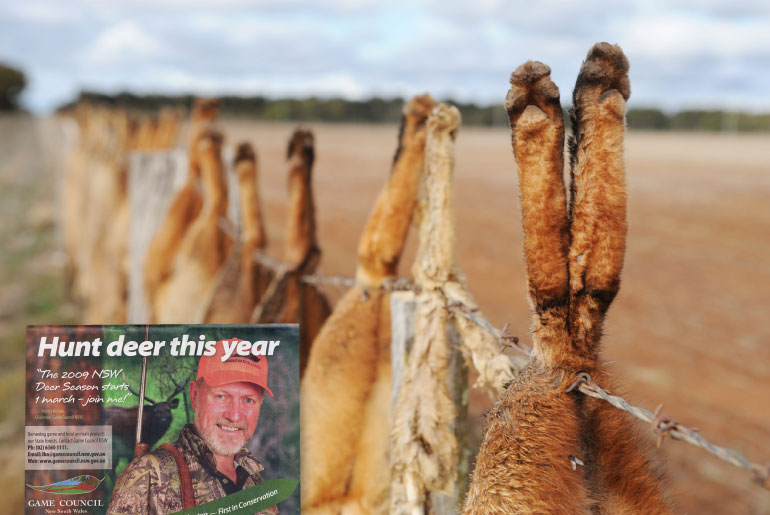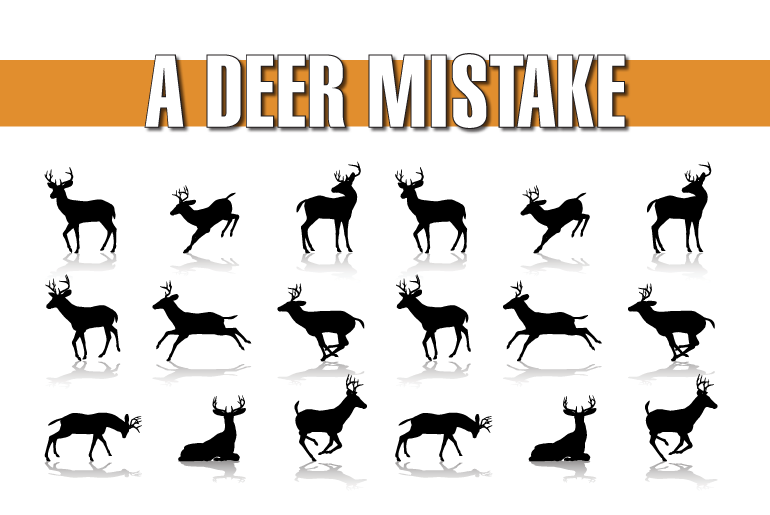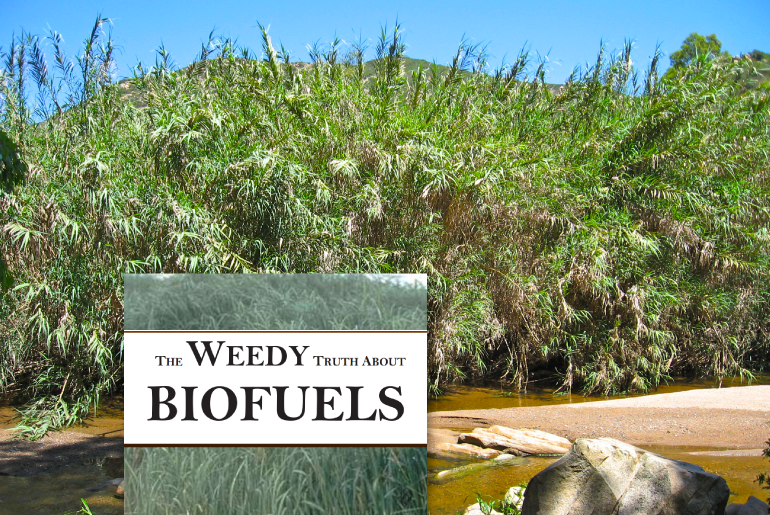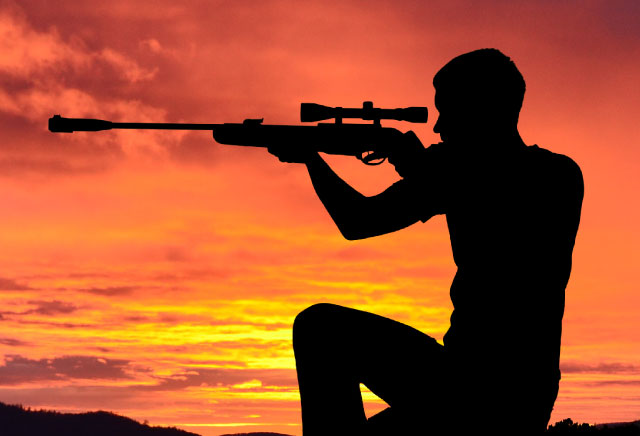
Is hunting conservation?
In this critique our policy officer Dr Carol Booth discusses ‘Recreational hunting and its place within Australia’, an issue of the Australian Shooters Journal, and asks is hunting conservation?

In this critique our policy officer Dr Carol Booth discusses ‘Recreational hunting and its place within Australia’, an issue of the Australian Shooters Journal, and asks is hunting conservation?
Along with land clearing and climate change, invasive species are one of the top three threats to Australia’s biodiversity. And yet the country’s Environment Protection

Feral animals cause severe damage to Australian wildlife and ecosystems. We strongly advocate eradication and control of feral animal populations to protect environmental values. Is recreational hunting effective for feral animal control?
The draft management strategy for hog deer in Victoria proposes goals and strategies that are anathema to best practice management of threatening invasive animals and

A preliminary assessment of a Victorian State Government plan inviting expressions of interest from landholders to take part in a scheme to facilitate recreational hunting of quail, duck and deer on private properties.
The Invasive Species Council supports the analysis contained in the draft submission and strongly recommends against allowing the import of savannah cats into Australia. The
While the Victorian Government’s Land and Biodiversity at a Time of Climate Change Green Paper appropriately acknowledges that invasive species are a major threat to
The Invasive Species Council is concerned about a number of issues surrounding Australia’s federal quarantine and biosecurity system, including: Cultural issues. Failure to implement polluter

In this ground-breaking report author Tim Low warns that most plants being promoted as biofuels in Australia are serious weeds that should not be grown. As well as the full report there is also a summary report available for download.

July 2007
This report by WWF-Australia examines the threat posed by poisonous garden plants and makes five recommendations for low-cost solutions.

2005
The report by the Australian Biosecurity Group proposes a framework to strengthen Australia’s biosecurity shield to protect us from weeds, pests and diseases consisting of ten elements.
May 2004
A list of over 1,000 garden plants that are invasive and potentially invasive classified according to their national importance.
Inquiry into the regulation, control and management of invasive species and the Environment Protection and Biodiversity Conservation Amendment (Invasive Species) Bill 2002. All submissions to

Invasive animals, particularly foxes, cats, rabbits and rats, have caused most of Australia’s animal extinctions and imperil many more species. Hardhoofed feral herbivores like goats

A ‘white list’ or ‘permitted list’ approach to the sale and movement of plants is the safest way to prevent the spread of potentially weedy plants.

In this critique our policy officer Dr Carol Booth discusses ‘Recreational hunting and its place within Australia’, an issue of the Australian Shooters Journal, and asks is hunting conservation?
Along with land clearing and climate change, invasive species are one of the top three threats to Australia’s biodiversity. And yet the country’s Environment Protection

Feral animals cause severe damage to Australian wildlife and ecosystems. We strongly advocate eradication and control of feral animal populations to protect environmental values. Is recreational hunting effective for feral animal control?
The draft management strategy for hog deer in Victoria proposes goals and strategies that are anathema to best practice management of threatening invasive animals and

A preliminary assessment of a Victorian State Government plan inviting expressions of interest from landholders to take part in a scheme to facilitate recreational hunting of quail, duck and deer on private properties.
The Invasive Species Council supports the analysis contained in the draft submission and strongly recommends against allowing the import of savannah cats into Australia. The
While the Victorian Government’s Land and Biodiversity at a Time of Climate Change Green Paper appropriately acknowledges that invasive species are a major threat to
The Invasive Species Council is concerned about a number of issues surrounding Australia’s federal quarantine and biosecurity system, including: Cultural issues. Failure to implement polluter

In this ground-breaking report author Tim Low warns that most plants being promoted as biofuels in Australia are serious weeds that should not be grown. As well as the full report there is also a summary report available for download.

July 2007
This report by WWF-Australia examines the threat posed by poisonous garden plants and makes five recommendations for low-cost solutions.

2005
The report by the Australian Biosecurity Group proposes a framework to strengthen Australia’s biosecurity shield to protect us from weeds, pests and diseases consisting of ten elements.
May 2004
A list of over 1,000 garden plants that are invasive and potentially invasive classified according to their national importance.
Inquiry into the regulation, control and management of invasive species and the Environment Protection and Biodiversity Conservation Amendment (Invasive Species) Bill 2002. All submissions to

Invasive animals, particularly foxes, cats, rabbits and rats, have caused most of Australia’s animal extinctions and imperil many more species. Hardhoofed feral herbivores like goats

A ‘white list’ or ‘permitted list’ approach to the sale and movement of plants is the safest way to prevent the spread of potentially weedy plants.

In this critique our policy officer Dr Carol Booth discusses ‘Recreational hunting and its place within Australia’, an issue of the Australian Shooters Journal, and asks is hunting conservation?
Along with land clearing and climate change, invasive species are one of the top three threats to Australia’s biodiversity. And yet the country’s Environment Protection

Feral animals cause severe damage to Australian wildlife and ecosystems. We strongly advocate eradication and control of feral animal populations to protect environmental values. Is recreational hunting effective for feral animal control?
The draft management strategy for hog deer in Victoria proposes goals and strategies that are anathema to best practice management of threatening invasive animals and

A preliminary assessment of a Victorian State Government plan inviting expressions of interest from landholders to take part in a scheme to facilitate recreational hunting of quail, duck and deer on private properties.
The Invasive Species Council supports the analysis contained in the draft submission and strongly recommends against allowing the import of savannah cats into Australia. The
While the Victorian Government’s Land and Biodiversity at a Time of Climate Change Green Paper appropriately acknowledges that invasive species are a major threat to
The Invasive Species Council is concerned about a number of issues surrounding Australia’s federal quarantine and biosecurity system, including: Cultural issues. Failure to implement polluter

In this ground-breaking report author Tim Low warns that most plants being promoted as biofuels in Australia are serious weeds that should not be grown. As well as the full report there is also a summary report available for download.

July 2007
This report by WWF-Australia examines the threat posed by poisonous garden plants and makes five recommendations for low-cost solutions.

2005
The report by the Australian Biosecurity Group proposes a framework to strengthen Australia’s biosecurity shield to protect us from weeds, pests and diseases consisting of ten elements.
May 2004
A list of over 1,000 garden plants that are invasive and potentially invasive classified according to their national importance.
Inquiry into the regulation, control and management of invasive species and the Environment Protection and Biodiversity Conservation Amendment (Invasive Species) Bill 2002. All submissions to

Invasive animals, particularly foxes, cats, rabbits and rats, have caused most of Australia’s animal extinctions and imperil many more species. Hardhoofed feral herbivores like goats

A ‘white list’ or ‘permitted list’ approach to the sale and movement of plants is the safest way to prevent the spread of potentially weedy plants.
Get our blog the Feral Herald delivered to your inbox.
Our protected areas are being trashed, trampled, choked and polluted by an onslaught of invaders. Invasive species are already the overwhelming driver of our animal extinction rate, and are expected to cause 75 of the next 100 extinctions.
But you can help to turn this around and create a wildlife revival in Australia.
From numbats to night parrots, a tax-deductible donation today can help defend our wildlife against the threat of invasive weeds, predators, and diseases.
As the only national advocacy environment group dedicated to stopping this mega threat, your gift will make a big difference.
A silent crisis is unfolding across Australia. Every year, billions of native animals are hunted and killed by cats and foxes. Fire ants continue to spread and threaten human health. And the deadly strain of bird flu looms on the horizon. Your donation today will be used to put the invasive species threat in the media, make invasive species a government priority, ensure governments take rapid action to protect nature and our remarkable native wildlife from invasives-led extinction, death and destruction.
If you are having trouble submitting a form, please read this guide.
Please fill out the following form and one of our team will be in contact to assist as soon as possible. Please make sure to include any helpful information, such as the device you were using (computer, tablet or mobile phone) and if known, your browser (Mozilla Firefox, Chrome, Safari etc)
"*" indicates required fields
Dear Project Team,
[YOUR PERSONALISED MESSAGE WILL APPEAR HERE.]
I support the amendment to the Kosciuszko National Park Wild Horse Heritage Management Plan to allow our incredible National Parks staff to use aerial shooting as one method to rapidly reduce feral horse numbers. I want to see feral horse numbers urgently reduced in order to save the national park and our native wildlife that live there.
The current approach is not solving the problem. Feral horse numbers have rapidly increased in Kosciuszko National Park to around 18,000, a 30% jump in just the past 2 years. With the population so high, thousands of feral horses need to be removed annually to reduce numbers and stop our National Park becoming a horse paddock. Aerial shooting, undertaken humanely and safely by professionals using standard protocols, is the only way this can happen.
The government’s own management plan for feral horses states that ‘if undertaken in accordance with best practice, aerial shooting can have the lowest negative animal welfare impacts of all lethal control methods’.
This humane and effective practice is already used across Australia to manage hundreds of thousands of feral animals like horses, deer, pigs, and goats.
Trapping and rehoming of feral horses has been used in Kosciuszko National Park for well over a decade but has consistently failed to reduce the population, has delayed meaningful action and is expensive. There are too many feral horses in the Alps and not enough demand for rehoming for it to be relied upon for the reduction of the population.
Fertility control as a management tool is only effective for a small, geographically isolated, and accessible population of feral horses where the management outcome sought is to maintain the population at its current size. It is not a viable option to reduce the large and growing feral horse population in the vast and rugged terrain of Kosciuszko National Park.
Feral horses are trashing and trampling our sensitive alpine ecosystems and streams, causing the decline and extinction of native animals. The federal government’s Threatened Species Scientific Committee has stated that feral horses ‘may be the crucial factor that causes final extinction’ for 12 alpine species.
I recognise the sad reality that urgent and humane measures are necessary to urgently remove the horses or they will destroy the Snowies and the native wildlife that call the mountains home. I support a healthy national park where native species like the Corroboree Frog and Mountain Pygmy Possum can thrive.
Dear Project Team,
[YOUR PERSONALISED MESSAGE WILL APPEAR HERE.]
I support the amendment to the Kosciuszko National Park Wild Horse Heritage Management Plan to allow our incredible National Parks staff to use aerial shooting as one method to rapidly reduce feral horse numbers. I want to see feral horse numbers urgently reduced in order to save the national park and our native wildlife that live there.
The current approach is not solving the problem. Feral horse numbers have rapidly increased in Kosciuszko National Park to around 18,000, a 30% jump in just the past 2 years. With the population so high, thousands of feral horses need to be removed annually to reduce numbers and stop our National Park becoming a horse paddock. Aerial shooting, undertaken humanely and safely by professionals using standard protocols, is the only way this can happen.
The government’s own management plan for feral horses states that ‘if undertaken in accordance with best practice, aerial shooting can have the lowest negative animal welfare impacts of all lethal control methods’.
This humane and effective practice is already used across Australia to manage hundreds of thousands of feral animals like horses, deer, pigs, and goats.
Trapping and rehoming of feral horses has been used in Kosciuszko National Park for well over a decade but has consistently failed to reduce the population, has delayed meaningful action and is expensive. There are too many feral horses in the Alps and not enough demand for rehoming for it to be relied upon for the reduction of the population.
Fertility control as a management tool is only effective for a small, geographically isolated, and accessible population of feral horses where the management outcome sought is to maintain the population at its current size. It is not a viable option to reduce the large and growing feral horse population in the vast and rugged terrain of Kosciuszko National Park.
Feral horses are trashing and trampling our sensitive alpine ecosystems and streams, causing the decline and extinction of native animals. The federal government’s Threatened Species Scientific Committee has stated that feral horses ‘may be the crucial factor that causes final extinction’ for 12 alpine species.
I recognise the sad reality that urgent and humane measures are necessary to urgently remove the horses or they will destroy the Snowies and the native wildlife that call the mountains home. I support a healthy national park where native species like the Corroboree Frog and Mountain Pygmy Possum can thrive.